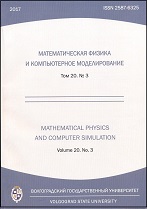|
This article is cited in 5 scientific papers (total in 5 papers)
Mathematics
Dimension of spaces of solutions of the Schrodinger equation on noncompact riemannian manifolds
A. A. Grigor'yana, A. G. Losevb
a Bielefeld University
b Volgograd State University
Abstract:
Let $M$ be a smooth connected noncompact Riemannian manifold, $\Delta$ the Laplace — Beltrami operator on $M,$ $q(x)$ a smooth nonnegative function on $M,$
not identically zero. Considering the Schrodinger equation on $M,$
$$
\Delta u - q(x)u=0,
$$
we ask the following question: For what manifold $M$ and potentials $q(x)$ does this equation have a unique solutions $u=0?$ If this is the case we say that Liouville's theorem is true for Schrodinger equation.
We say that $u$ is $q$-harmonic function if it satisfies the Schrodinger equation.
The classical Liouville theorem says that any bounded harmonic function in $R^n$ is identically constant.
We note that recently there has been a trend towards a more general
approach to theorems of Liouville type, namely, they are estimated
dimensionality of various solution spaces of linear equations
elliptic type.
In particular, Grigor'yan (1990) proved an exact estimate
dimensionality of spaces of bounded harmonic functions on
non-compact Riemannian manifolds in terms of massive
sets. The aim of this paper is to prove a similar
result for bounded solutions of the stationary equation
Schrodinger.
Dimensions of spaces of harmonic functions and $q$-harmonic functions has been studied in numerous articles for various classes of manifolds. Among them are the works of M.T. Anderson, T.H. Colding, A. Grigor'yan, P. Li, A.G. Losev, L.-F. Tam, D. Sullivan, S.-T. Yau and many other authors. In contrast to the mentioned articles (and many others), we do not restrict the manifold $M$ a priori in any way.
Let $LB(M)$ be the space of bounded $q$-harmonic functions on $M.$
We define $q$-massive subsets of $M$ and prove that $LB(M)$ is equal to the maximal number of pairwise non-intersecting $q$-massive subsets of $M.$
We now state the exact formulations.
A continuous function $u$ defined on some open set $\Omega \subset M$ is called $q$-subharmonic if for every domain $G\Subset \Omega$ and a $q$-harmonic function
$$v\in C(\overline{G}), \quad u|_{\partial G}=v|_{\partial G} $$
implies $u\leq v$ in $G.$
An open proper subset $\Omega \subset M$ is called $q$-massive if there is a non-trival $q$-subharmonic function $u\in C(\overline{\Omega})$ such that $u|_{\partial \Omega}=0, \quad 0\leq u \leq 1. $
The main result of the paper is the following statement.
Theorem. Let $m\geq 1$ be a natural number. The following statements are equivalent:
1) $\dim LB(M)\geq m;$
2) there exist $m$ pairwise non-intersection $q$-massive subsets of $M.$
Note that in the case $ q (x) \equiv 0, $ this assertion is true only for $ m \geq 2. $
Keywords:
stationary Schrodinger equation, Liouville-type theorems, non- compact Riemannian manifolds, massive sets, dimension of spaces of solutions.
Citation:
A. A. Grigor'yan, A. G. Losev, “Dimension of spaces of solutions of the Schrodinger equation on noncompact riemannian manifolds”, Mathematical Physics and Computer Simulation, 20:3 (2017), 34–42
Linking options:
https://www.mathnet.ru/eng/vvgum181 https://www.mathnet.ru/eng/vvgum/v20/i3/p34
|

| Statistics & downloads: |
| Abstract page: | 449 | | Full-text PDF : | 225 | | References: | 43 |
|




 Contact us:
Contact us: Terms of Use
Terms of Use
 Registration to the website
Registration to the website Logotypes
Logotypes








 Citation in format
Citation in format 
